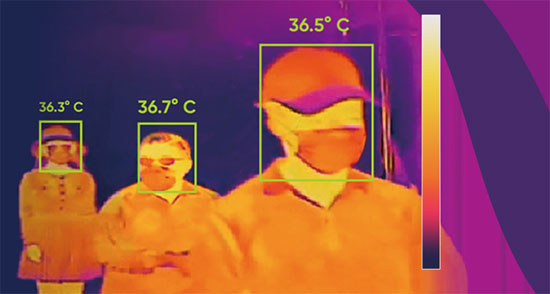By Jamie Bumgardner, Prime Communications, Inc.
Thermal cameras have been a hot topic in the security industry as of late, as more and more businesses look to invest in solutions that can screen employees and customers for an elevated temperature before they enter a building. Thermal cameras are being used as one of many tools and protocols to help prevent the spread of COVID-19, since an elevated temperature is one of the most common symptoms of the virus.
Over the past few months, numerous companies have raced to develop and launch thermal camera solutions for the security industry. While hospitals, casinos, restaurants and even schools are among those who have already made the investment in this technology, facility executives and security directors should take into consideration the following as part of the buying and evaluation process of thermal imaging cameras.
Look at the accuracy rate of the device and how frequently the camera needs to be calibrated. Does the camera use a black body device, which helps to maintain accuracy when measuring the temperature of a person’s forehead or inner canthus? Also, the black body device should arrive fully calibrated and should only need to be recalibrated every few months.
Is the camera an FDA approved medical device? The FDA has issued guidelines on the use of “telethermographic systems.” An FDA approved thermal imaging camera meets IEC standards, which dictate accuracy rate and throughput guidelines, such as screening only one individual at a time.
How will the thermal data be stored? This is a question that needs to be addressed in order to ensure privacy and data security rules are followed, such as GDPR and California’s CCPA rule. Much like video collected and stored as part of a VMS system, data collected as part of a thermal imaging camera scan also requires privacy protection measures.
Many businesses will test and try out a new keypad, IP camera or access control reader before making that purchase. The same approach should be taken with thermal imaging cameras. Work closely with your security systems integrator to thoroughly vet and test the technology prior to buying it.
What’s the long-term value of this camera to your business or organization? Do you expect to be able to use this camera post-COVID as part of your company’s surveillance program or will it go into the closet waiting for the next pandemic? Make sure you have a plan in place for what you do with these thermal imaging cameras post-pandemic.
As people look to return to work and to school, consider collaborating with your systems integrator partner about which safety protocols and technologies, like thermal imaging cameras, you can put into place to help to make that transition possible.









Leave a Reply
Want to join the discussion?Feel free to contribute!